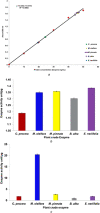Method development for optimised green synthesis of gold nanoparticles from Millettia pinnata and their activity in non-small cell lung cancer cell lines
- PMID: 31432797
- PMCID: PMC8676050
- DOI: 10.1049/iet-nbt.2018.5410
Method development for optimised green synthesis of gold nanoparticles from Millettia pinnata and their activity in non-small cell lung cancer cell lines
Abstract
Green synthesis of gold nanoparticles (GNPs) has received substantial attention, because nanoparticles are produced in an eco-friendly way using biomolecules present in plant extracts in a single step reaction. This research article highlights GNPs obtained using shade-dried leaf extracts of Millettia pinnata (L.) with aqueous auric chloride (HAuCl4) at ambient temperature. In the present study, GNPs with average particle size 37 nm in size were fabricated. Furthermore, the synthesis method to obtain stable and monodispersed GNPs was advanced by optimising enzyme concentration 100 μg/ml, pH 5.4, substrate concentration 0.45 mM and 12 h time of reaction. The confirmation of GNPs formation and characterisation was followed by UV-vis-absorption spectroscopy, dynamic light scattering (DLS), and zeta potential (ZP) for the analysis of shape, size, and stability, respectively. TEM images and powder XRD revealed the GNPs synthesis of spherical-shaped nanoparticles in the face-centred cubic arrangement. Cytotoxicity of GNPs was studied against A549 lung cancer cells with IC50 14.76 μg/ml and found lower as compared to doxorubicin IC50 11.23 μg/ml but significant enough to be used as a vehicle GNPs produced using green source can be used as significant therapeutic agents and drug delivery carriers.
Figures








References
-
- Jeong E. H. Jung G. Am Hong C. et al.: ‘Gold nanoparticle (AuNP)‐based drug delivery and molecular imaging for biomedical applications’, Arch. Pharmacal Res., 2014, 37, (1), pp. 53 –59 - PubMed
-
- Daraee H. Eatemadi A. Abbasi E. et al.: ‘Application of gold nanoparticles in biomedical and drug delivery’, Artif. Cells Nanomed. Biotechnol., 2016, 44, (1), pp. 410 –422 - PubMed
-
- Mafuné F Kohno J. Y Takeda Y et al.: ‘Full physical preparation of size‐selected gold nanoparticles in solution: laser ablation and laser‐induced size control’, J. Phys. Chem. B, 2002, 106, (31), pp. 7575 –7577
-
- Gupta R. Padmanabhan P.: ‘Biogenic synthesis and characterization of gold nanoparticles by a novel marine bacteria marinobacter algicola: progression from nanospheres to various geometrical shapes’, J. Microbiol. Biotechnol. Food Sci., 2018, 8, (1), pp. 732 –737
MeSH terms
Substances
LinkOut - more resources
Full Text Sources
Medical

